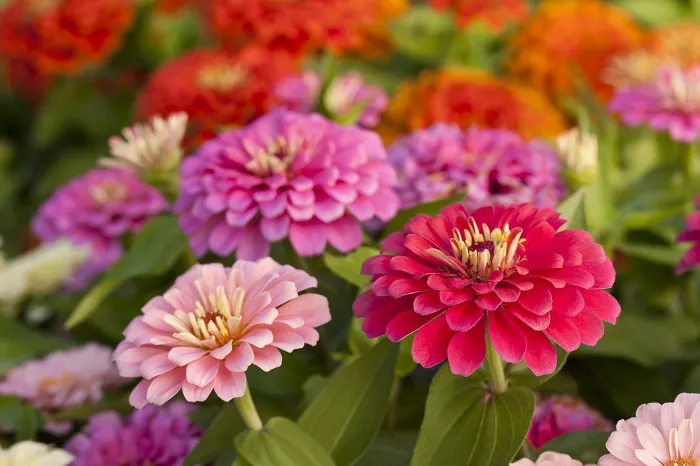Zinnias are vibrant and easy-to-grow flowers that can add a splash of color to any garden. Whether you’re a seasoned gardener or a beginner, planting zinnia seeds is a rewarding project. In this article, we will explore the steps to successfully plant and nurture zinnia seeds, ensuring a beautiful bloom.
Choosing the Right Zinnia Seeds
When it comes to planting zinnias, the first step is selecting the right seeds. Zinnias come in a variety of colors and sizes, from bright yellows and pinks to deep purples and reds. Consider the space you have available and the desired aesthetic for your garden. Some popular varieties include the “Lilliput” mix for smaller gardens and the “State Fair” mix for larger, more dramatic displays.
Where to Buy Zinnia Seeds
You can find zinnia seeds at your local nursery or online. Look for reputable seed suppliers that offer high-quality, non-GMO seeds. Reading reviews and checking for certifications can help ensure you’re getting the best product.
Preparing the Soil
Zinnias thrive in well-drained soil with plenty of organic matter. Before planting, it’s essential to prepare the soil properly.
Soil Composition
Zinnias prefer a slightly acidic to neutral soil pH, around 6.0 to 7.5. You can test your soil using a home testing kit or by sending a sample to a local agricultural extension office. If your soil is too acidic, adding lime can help adjust the pH.
Amending the Soil
To enrich the soil, mix in compost or well-rotted manure. This will provide essential nutrients and improve soil structure. Avoid using fresh manure, as it can burn the seeds and young plants.
When to Plant Zinnia Seeds
Timing is crucial when planting zinnia seeds. These flowers are sensitive to frost, so it’s best to wait until the danger of frost has passed.
Planting in Spring
In most regions, late spring is the ideal time to plant zinnia seeds. This ensures that the soil is warm enough for germination, typically around 70°F (21°C). If you live in a warmer climate, you may be able to plant earlier.
Starting Indoors
If you want a head start, you can begin zinnia seeds indoors about four to six weeks before the last expected frost. Use biodegradable pots to minimize transplant shock when moving the seedlings outdoors.
Planting Zinnia Seeds Outdoors
Once the soil is prepared and the weather is right, it’s time to plant your zinnia seeds.
Sowing the Seeds
Plant zinnia seeds about 1/4 inch deep and 2 to 3 inches apart. This spacing allows the seedlings room to grow without competing for light and nutrients. For larger varieties, increase the spacing to 4 to 6 inches.
Watering
After planting, water the seeds gently but thoroughly. Keep the soil consistently moist but not waterlogged. Overwatering can lead to damping off, a fungal disease that affects seedlings.
Caring for Zinnia Seedlings
As your zinnia seeds germinate and grow into seedlings, proper care is essential for healthy development.
Thinning Seedlings
Once the seedlings have two sets of true leaves, thin them out to the recommended spacing for the variety you’re growing. This ensures each plant has enough space to grow and reduces competition for resources.
Fertilizing
Zinnias benefit from regular feeding. Use a balanced, water-soluble fertilizer every two to three weeks. Be careful not to over-fertilize, as this can lead to weak, leggy growth.
Common Problems and Solutions
Growing zinnias can come with a few challenges, but with proper care, these issues can be easily managed.
Pests
Aphids and spider mites are common pests that can affect zinnias. Regularly inspect your plants and use organic insecticidal soap to control infestations. Encouraging beneficial insects like ladybugs can also help keep pests at bay.
Diseases
Powdery mildew is a common disease in zinnias, especially in humid conditions. To prevent this, ensure good air circulation around the plants and avoid overhead watering. If mildew appears, remove affected leaves and treat with a fungicide.
Harvesting and Enjoying Zinnias
One of the joys of growing zinnias is harvesting the beautiful blooms.
Cutting Flowers
Zinnias make excellent cut flowers. Harvest them when the blooms are fully open but still firm. Cut the stems at an angle and place them in a vase with clean water. Change the water every few days to prolong their life.
Saving Seeds
If you want to grow zinnias again next year, you can save seeds from your healthiest plants. Allow the flowers to dry on the stem, then collect and store the seeds in a cool, dry place.
Conclusion
Planting zinnia seeds is a delightful gardening activity that brings vibrant colors and beauty to your outdoor space. With the right preparation, care, and attention, you can enjoy a stunning display of zinnias throughout the growing season. Whether you’re planting for the first time or looking to expand your garden, zinnias are a wonderful addition.


